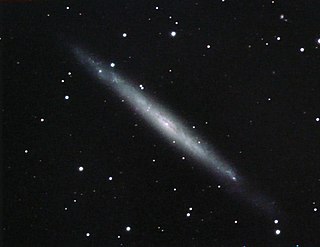
NGC 4244, also known as Caldwell 26, is an edge-on loose spiral galaxy in the constellation Canes Venatici, and is part of the M94 Group or Canes Venatici I Group, a galaxy group relatively close to the Local Group containing the Milky Way. In the sky, it is located near the yellow naked-eye star, Beta Canum Venaticorum, but also near the barred spiral galaxy NGC 4151 and irregular galaxy NGC 4214.

NGC 3632 and NGC 3626 is an unbarred lenticular galaxy and Caldwell object in the constellation Leo. It was discovered by William Herschel, on 14 March 1784. It shines at magnitude +10.6/+10.9. Its celestial coordinates are RA 11h 20.1m, dec +18° 21′. It is located near the naked-eye-class A4 star Zosma, as well as galaxies NGC 3608, NGC 3607, NGC 3659, NGC 3686, NGC 3684, NGC 3691, NGC 3681, and NGC 3655. Its dimensions are 2′.7 × 1′.9. The galaxy belongs to the NGC 3607 group some 70 million light-years distant, itself one of the many Leo II groups.
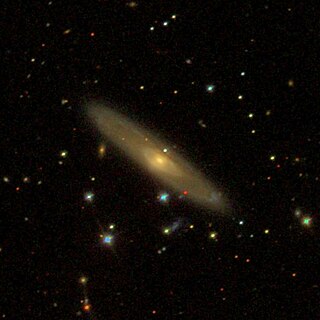
NGC 13 is a spiral galaxy in the constellation Andromeda. It is estimated to be about 220 million light-years away from the Sun. It was discovered on November 26, 1790, by William Herschel.

NGC 5792 is a barred spiral galaxy about 70 million light-years away in the constellation Libra. There is a magnitude 9.6 star on the northwestern edge of the galaxy. It was discovered on April 11, 1787, by the astronomer William Herschel. It is a member of the Virgo III Groups, a series of galaxies and galaxy clusters strung out to the east of the Virgo Supercluster of galaxies.

Arp 271 is a pair of similarly sized interacting spiral galaxies, NGC 5426 and NGC 5427, in the constellation of Virgo. It is not certain whether the galaxies are going to eventually collide or not. They will continue interacting for tens of millions of years, creating new stars as a result of the mutual gravitational attraction between the galaxies, a pull seen in the bridge of stars already connecting the two. Located about 130 million light-years away, the Arp 271 pair is about 130,000 light-years across. It was originally discovered in 1785 by William Herschel. It is speculated, that the Milky Way will undergo a similar collision in about five billion years with the neighbouring Andromeda Galaxy, which is currently located about 2.6 million light-years away.

NGC 5970 is a large barred-spiral galaxy located about 90 million light years away in the constellation Serpens Caput. It appears to have two satellite or companion galaxies. It is a member of the Virgo Cluster of galaxies. It was discovered on March 15, 1784, by the astronomer William Herschel.

NGC 4866 is an unbarred lenticular galaxy located roughly 100 million light-years away in the constellation Virgo. It was first observed by British astronomer Sir William Herschel on January 14, 1787. It is a member of the Virgo Cluster.

NGC 75 is a lenticular galaxy estimated to be about 260 million light-years away in the constellation of Pisces. It was discovered by Lewis A. Swift from the USA in 1886 and its magnitude is 13.2.

NGC 128 is a lenticular galaxy in the constellation Pisces. It is approximately 190 million light-years from the Sun and has a diameter of about 165,000 light-years.

NGC 3794, also cataloged in the New General Catalogue as NGC 3804, is a low-surface-brightness galaxy in the constellation Ursa Major. It is very far from Earth, with a distance of about 68,470,000 light-years (20,990,000 pc). It was discovered on April 14, 1789, by the astronomer William Herschel.
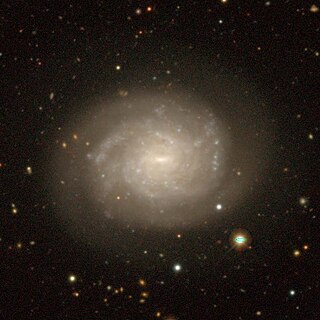
NGC 1310 is a barred spiral galaxy located in the southern constellation of Fornax. It was discovered by English astronomer John Herschel on 22 October 1835.
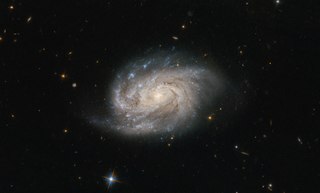
NGC 1803 is a barred spiral galaxy located around 192 million light-years away in the constellation Pictor. NGC 1803 was discovered in 1834 by John Herschel, and it is 87,000 light-years across.

NGC 970 is an interacting galaxy pair in the constellation Triangulum. It is estimated to be 471 million light-years from the Milky Way and has a diameter of approximately 100,000 ly. The object was discovered on September 14, 1850, by Bindon Blood Stoney.

NGC 823, also known as IC 1782, is an unbarred lenticular galaxy in the constellation Fornax. It is estimated to be 194 million light-years from the Milky Way and has a diameter of approximately 100,000 light years. NGC 823 was discovered on October 14, 1830, by astronomer John Herschel.
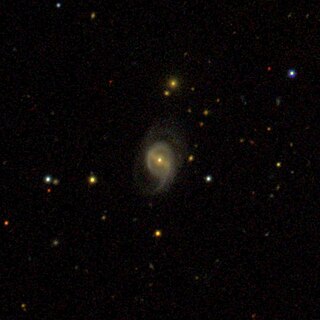
NGC 734 is a lenticular galaxy with a central bar in the constellation Cetus, which is about 538 million light years from the Milky Way. It was discovered on November 9, 1885, by the American astronomer Francis Preserved Leavenworth.

NGC 5619 is an intermediate spiral galaxy in the constellation Virgo. The galaxy was found on April 10, 1828, by the British astronomer John Herschel. It is located about 390 million light-years away from the Sun.

NGC 532 is a spiral galaxy in the constellation Pisces. The galaxy is approximately 100 million light-years away from the Earth, and was discovered on September 21, 1786, by the German-British astronomer William Herschel.

NGC 3008 is a lenticular galaxy with an active galactic nucleus in the constellation of Ursa Major, discovered by William Parsons and his assistants. It is about 40 thousand light years across, and with a recessional velocity of about 4,785 kilometers per second, is at a distance of 240 million light-years from the Sun.

NGC 3172 is a lenticular galaxy located in the constellation Ursa Minor. It is the closest NGC object to the north celestial pole. Discovered by John Herschel in 1831, it is about 285 million light-years away and about 85 thousand light-years across.

NGC 3902 is an intermediate spiral galaxy in the constellation Leo. It was discovered on April 6, 1785, by William Herschel and observed on February 19, 1827, by John Herschel. It is estimated to be 180 to 185 million light-years away, and its redshift-independent distance estimates to about 185 to 240 million light-years. It is around 75,000 light-years in diameter.




















